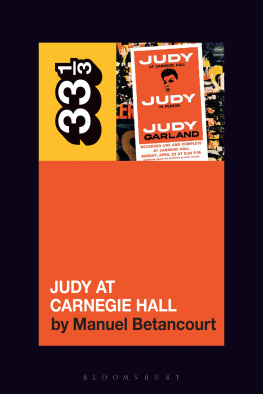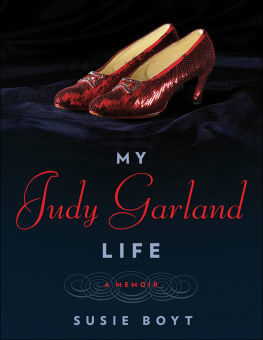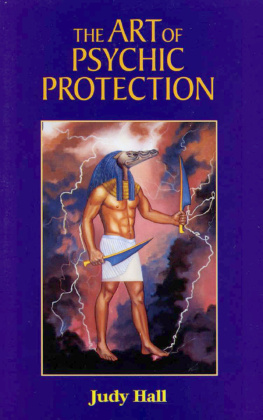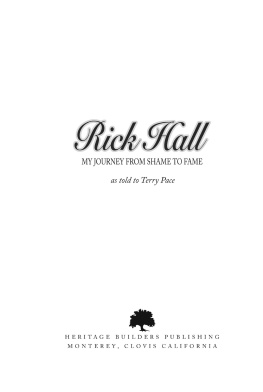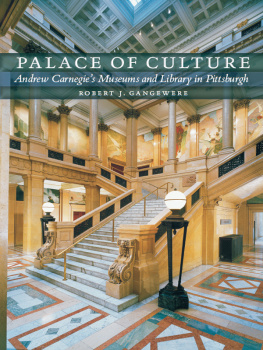
JUDY AT CARNEGIE HALL
Praise for the series:
It was only a matter of time before a clever publisher realized that there is an audience for whom Exile on Main Street or Electric Ladyland are as significant and worthy of study as The Catcher in the Rye or Middlemarch ... The series... is freewheeling and eclectic, ranging from minute rock-geek analysis to idiosyncratic personal celebration The New York Times Book Review
Ideal for the rock geek who thinks liner notes just arent enough Rolling Stone
One of the coolest publishing imprints on the planet Bookslut
These are for the insane collectors out there who appreciate fantastic design, well-executed thinking, and things that make your house look cool. Each volume in this series takes a seminal album and breaks it down in startling minutiae. We love these. We are huge nerds Vice
A brilliant series... each one a work of real love NME (UK)
Passionate, obsessive, and smart Nylon
Religious tracts for the rock n roll faithful Boldtype
[A] consistently excellent series Uncut (UK)
We... arent naive enough to think that were your only source for reading about music (but if we had our way... watch out). For those of you who really like to know everything there is to know about an album, youd do well to check out Bloomsburys 33 1/3 series of books Pitchfork
For reviews of individual titles in the series, please visit our blog at 333sound.com and our website at http://www.bloomsbury.com/musicandsoundstudies Follow us on Twitter: @333books
Like us on Facebook: https://www.facebook.com/33.3books
For a complete list of books in this series, see the back of this book.
Forthcoming in the series:
Im Your Fan: The Songs of Leonard Cohen by Ray Padgett
Timeless by Martin Deykers
The Velvet Rope by Ayanna Dozier
Band of Gypsys by Michael E. Veal
From Elvis in Memphis by Eric Wolfson
Suicide by Andi Coulter
Ghetto: Misfortunes Wealth by Zach Schonfeld
Live at the Harlem Square Club, 1963 by Colin Fleming
Murder Ballads by Santi Elijah Holley
Once Upon a Time by Alex Jeffery
Tapestry by Loren Glass
Tin Drum by Agata Pyzik
The Archandroid by Alyssa Favreau
Avalon by Simon Morrison
Rio by Annie Zaleski
Vs. by Clint Brownlee
xx by Jane Morgan
and many more
Thank you to Matt, my best Judy
Judy At Carnegie Hall

Manuel Betancourt

Contents
The cover image for Judy at Carnegie Hall is a study in reproductions. The artwork, overseen by Capitol Records art director Jim Silke, borrows the design for the poster used to advertise the legendary evening in 1961 when Judy Garland performed at the famed New York City institution.
Framed by a wide white margin, a blood orange background bears her name three times in bold capital letters: JUDY JUDY JUDY. The first doubles as the albums title (AT CARNEGIE HALL is printed right below it). The second stresses an obvious yet important detail (telling us she was there IN PERSON). The third, meanwhile, just offers the sole selling point of such an event: GARLAND.
Its her name which dominates this minimalist poster, echoing the chant-like screams that dominated that evenings proceedings. This poster reproduction, flanked by a wall full of torn-down advertisements, encourages you to think that purchasing and later listening to this recording will transport you back to what the original liner notes describe as the greatest night in show business history.
The albums promise is the captured liveness of Judys presence. RECORDED LIVE AND COMPLETE it reads below her full name. The jacket copy for the double album LP went even further. The Carnegie Hall concert may only have boasted 3,165 attendees, but Now YOU, it promises, will join those privileged few and thrill to the very performance which has been captured live and undiluted in this album. You wont just be getting Judy singing her standards (Over the Rainbow, The Man That Got Away, and The Trolley Song, the three songs that make up the concerts Overture) but the sheer vibrancy of what it felt like to be in the audience when the Worlds Greatest Entertainer all but tired herself to death performing twenty-five numbers that were punctuated by the ecstatic cheers from the crowd.
While the July 1961 vinyl promised the complete concert, contemporary listeners have been able to access an even fuller version of what happened that evening. With Capitol Records 2-CD release in 1989 (the album has never been out of print), some of the excised recorded content from that night was restored; the DCC Compact Classics 2000 release, meanwhile, presented the concerts most uncut version to date. These later versions allow listeners to not only hear Judy sing but also revel in the various anecdotes she regaled her audiences with. Moreover, the track for Alone Together has been restored: on the original release the song on the album was rumored to have been a studio cut after the original recording from that night had been flawed (its a rare moment in the 1961 vinyl where no applause greets the opening bars of a song and a blip of silence follows its conclusion). If fans back then thought theyd been given access to that fateful night, those of us listening to the album in full can feel truly immersed in the kinetic energy that ran through the aisles of Carnegie Hall: raucous applause greets almost every number, sometimes with whoops and hollers going on for close to half a minute after Garland has sung her final note. This newer, more complete version makes good on the promise of that first vinyl: you feel like you, too, can witness history from the comfort of your own home, armed only with a good sound system. Maybe even just a pair of headphones.
Whats palpable in those extended, music-less moments filled with ecstatic crowd reactions is the pull Garland had over her audience, both that night and every time she took to the stage. Roger Edens, whod been instrumental in launching Garlands career at Metro-Goldwyn-Mayer (he arranged and rewrote for her the song that got her cast in her breakout role) and who had done the vocal arrangements for the concert, felt that the Carnegie Hall evening was unlike anything shed ever done. That concert laid bare the very essence of what made Garland such a magnetic performer, the reason why she was adored by so many.
Its right down deep inside, Edens told James Goode, who published a profile of Garland later that same year for the short-lived Show Business Illustrated , Good, solid, raw talent creates excitement. That was the charm of the Carnegie Hall concert. I had never seen her on [that] stage before. I still dont believe anything like this could happen. She practically burnt the house down. She said, Lets do it, as though she had never done it before. Its there and when she touches it, it emerges. Its alchemy.
That very alchemy is precisely what Judy at Carnegie Hall captures. Its also what makes writing about it so he wrote. Garlands fans dont often get discussed in the same tone used to talk about The Beatless (or Sinatras or Elviss fans). But thats mostly because, unlike the coded fangirl language used to discuss the mobs that assailed those male heartthrobs in concerts and airports alike, there wasnt an undercurrent of erotic energy within Judys crowds. It was all much more familial, though no less overwhelming.

